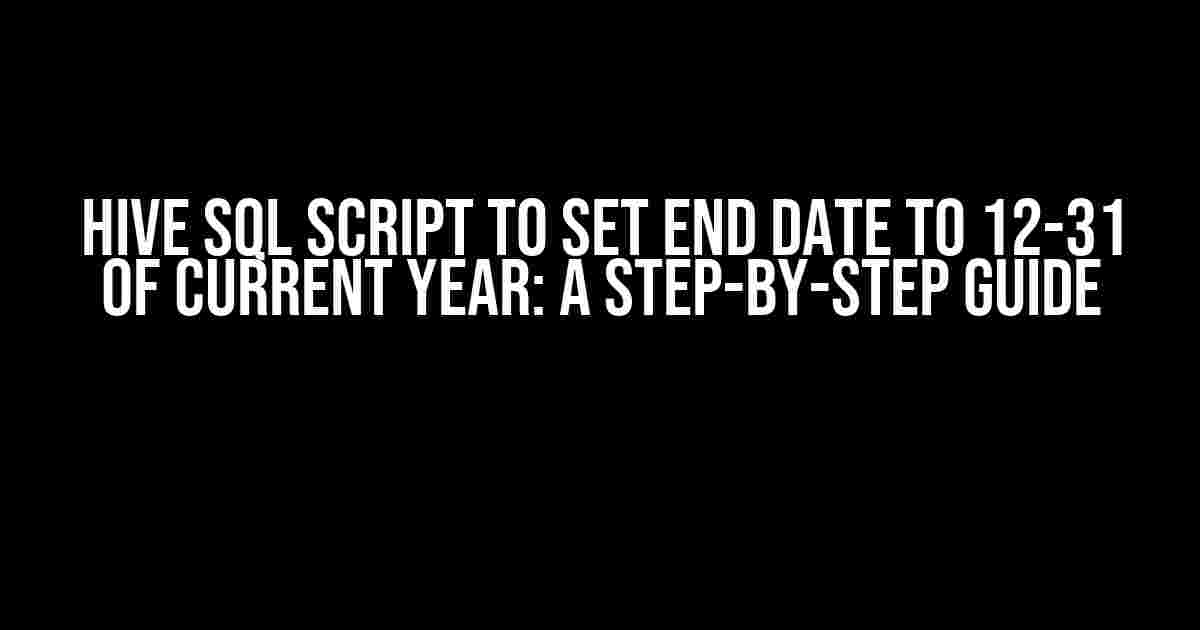Are you tired of manually updating the end date of your HIVE tables to the last day of the current year? Well, we’ve got some fantastic news for you! In this article, we’ll walk you through a simple yet effective HIVE SQL script that will automate this process for you. Say goodbye to manual updates and hello to more free time!
Why Do We Need to Set the End Date to 12-31 of Current Year?
Before we dive into the script, let’s quickly discuss why setting the end date to the last day of the current year is essential. In many scenarios, especially in data warehousing and business intelligence, it’s crucial to maintain accurate and up-to-date data. This includes ensuring that the end date of a particular period or event is correctly set to reflect the current year.
For instance, let’s say you’re working with a sales dataset, and you need to calculate the sales revenue for the current year. If the end date is not set correctly, your calculations will be inaccurate, leading to poor decision-making. By setting the end date to 12-31 of the current year, you can ensure that your data is always up-to-date and reflective of the current year.
The HIVE SQL Script to Set End Date to 12-31 of Current Year
-- Create a temporary table to store the current year
CREATE TEMPORARY TABLE current_year AS
SELECT year(current_timestamp) AS current_year;
-- Update the end date column to 12-31 of the current year
UPDATE your_table_name
SET end_date = TIMESTAMP('December 31, ' || (SELECT current_year FROM current_year));
-- Drop the temporary table
DROP TABLE current_year;
This script is straightforward and consists of three main steps:
- Create a temporary table to store the current year: We create a temporary table named
current_yearthat stores the current year using theyear(current_timestamp)function. - Update the end date column to 12-31 of the current year: We update the
end_datecolumn of our target table (your_table_name) by concatenating the string ‘December 31, ‘ with the current year obtained from the temporary table. The resulting timestamp is then set as the new end date. - Drop the temporary table: Finally, we drop the temporary table
current_yearto clean up and avoid any potential issues.
How to Implement the Script
To implement this script, follow these steps:
- Replace
your_table_namewith your actual table name: Update the script by replacingyour_table_namewith the name of the table where you want to set the end date to 12-31 of the current year. - Run the script in your HIVE console or editor: Copy and paste the script into your HIVE console or editor, and execute it. Make sure to replace the table name with the correct one.
- Verify the results: After running the script, verify that the end date column has been updated correctly by querying the table.
Tips and Variations
Here are some tips and variations to keep in mind when using this script:
- Use this script as a scheduled task: Consider scheduling this script to run regularly, such as daily or weekly, to ensure that your end dates are always up-to-date.
- Modify the script for different date formats: If your end date column has a different format, such as YYYYMMDD or YYYY-QQ, modify the script accordingly to accommodate the correct format.
- Use this script for other datetime columns: This script can be adapted to update other datetime columns, such as start dates, by simply modifying the column name and the date string.
Common Issues and Troubleshooting
If you encounter any issues while running this script, here are some common problems and solutions:
| Issue | Solution |
|---|---|
| Error: Table not found | Verify that the table name is correct and exists in your HIVE database. |
| Error: Invalid timestamp | Check that the end date column is in a compatible timestamp format. Modify the script if necessary. |
| Error: Permission denied | Verify that you have the necessary permissions to update the table. Consult your HIVE administrator if necessary. |
By following this guide, you should now have a seamless way to set the end date to 12-31 of the current year in your HIVE tables. Remember to adapt the script to your specific needs and troubleshoot any issues that may arise. Happy coding!
If you have any questions or need further assistance, feel free to ask in the comments below!
Frequently Asked Question
Hive SQL script to set end date to 12-31 of current year is a common query among data analysts. Here are some frequently asked questions and answers related to it.
What is the Hive SQL script to set end date to 12-31 of current year?
The Hive SQL script to set end date to 12-31 of current year is:
`UPDATE table_name SET end_date = DATE_SUB(DATE_ADD(DATE_TRUNC(‘year’, CURRENT_DATE), 1), 1);`
What does the DATE_SUB function do in the script?
The DATE_SUB function in the script subtracts one day from the result of the DATE_ADD function, effectively giving us the last day of the current year, which is December 31st.
What does the DATE_ADD function do in the script?
The DATE_ADD function in the script adds one year to the current date, effectively giving us the first day of the next year.
What is the purpose of using DATE_TRUNC in the script?
The DATE_TRUNC function in the script truncates the current date to the year level, effectively giving us the first day of the current year. This is necessary to add one year to it and get the first day of the next year.
Can I use this script in other SQL dialects?
While the script is specific to Hive SQL, similar functions and logic can be applied in other SQL dialects such as MySQL, PostgreSQL, and Oracle to achieve the same result. However, the exact syntax may vary.

